#First City Monument Bank
Explore tagged Tumblr posts
Text
FCMB invites applications for Accelerator Programme to empower one million SMEs across Nigeria.
First City Monument Bank (FCMB) has launched an accelerator programme to upskill and grow over one million small and medium-sized enterprises (SMEs) in Nigeria. This Nigeria news platform gathered that by partnering with SkillPaddy and other industry experts, the bank aims to equip startups and existing businesses with the skills and resources to develop innovative products and services, create…

View On WordPress
0 notes
Text
idk if people on tumblr know about this but a cybersecurity software called crowdstrike just did what is probably the single biggest fuck up in any sector in the past 10 years. it's monumentally bad. literally the most horror-inducing nightmare scenario for a tech company.
some info, crowdstrike is essentially an antivirus software for enterprises. which means normal laypeople cant really get it, they're for businesses and organisations and important stuff.
so, on a friday evening (it of course wasnt friday everywhere but it was friday evening in oceania which is where it first started causing damage due to europe and na being asleep), crowdstrike pushed out an update to their windows users that caused a bug.
before i get into what the bug is, know that friday evening is the worst possible time to do this because people are going home. the weekend is starting. offices dont have people in them. this is just one of many perfectly placed failures in the rube goldburg machine of crowdstrike. there's a reason friday is called 'dont push to live friday' or more to the point 'dont fuck it up friday'
so, at 3pm at friday, an update comes rolling into crowdstrike users which is automatically implemented. this update immediately causes the computer to blue screen of death. very very bad. but it's not simply a 'you need to restart' crash, because the computer then gets stuck into a boot loop.
this is the worst possible thing because, in a boot loop state, a computer is never really able to get to a point where it can do anything. like download a fix. so there is nothing crowdstrike can do to remedy this death update anymore. it is now left to the end users.
it was pretty quickly identified what the problem was. you had to boot it in safe mode, and a very small file needed to be deleted. or you could just rename crowdstrike to something else so windows never attempts to use it.
it's a fairly easy fix in the grand scheme of things, but the issue is that it is effecting enterprises. which can have a looooot of computers. in many different locations. so an IT person would need to manually fix hundreds of computers, sometimes in whole other cities and perhaps even other countries if theyre big enough.
another fuck up crowdstrike did was they did not stagger the update, so they could catch any mistakes before they wrecked havoc. (and also how how HOW do you not catch this before deploying it. this isn't a code oopsie this is a complete failure of quality ensurance that probably permeates the whole company to not realise their update was an instant kill). they rolled it out to everyone of their clients in the world at the same time.
and this seems pretty hilarious on the surface. i was havin a good chuckle as eftpos went down in the store i was working at, chaos was definitely ensuring lmao. im in aus, and banking was literally down nationwide.
but then you start hearing about the entire country's planes being grounded because the airport's computers are bricked. and hospitals having no computers anymore. emergency call centres crashing. and you realised that, wow. crowdstrike just killed people probably. this is literally the worst thing possible for a company like this to do.
crowdstrike was kinda on the come up too, they were starting to become a big name in the tech world as a new face. but that has definitely vanished now. to fuck up at this many places, is almost extremely impressive. its hard to even think of a comparable fuckup.
a friday evening simultaneous rollout boot loop is a phrase that haunts IT people in their darkest hours. it's the monster that drags people down into the swamp. it's the big bag in the horror movie. it's the end of the road. and for crowdstrike, that reaper of souls just knocked on their doorstep.
114K notes
·
View notes
Text
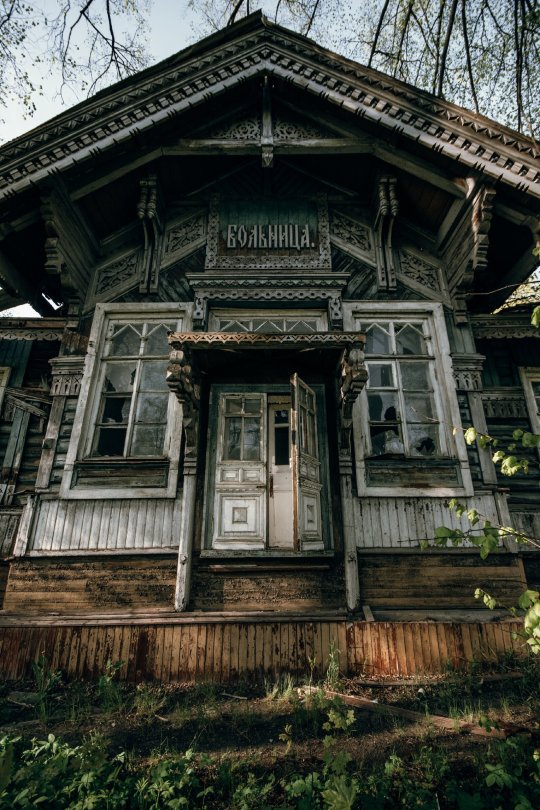

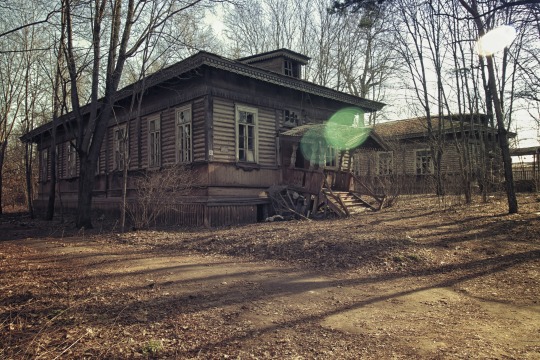
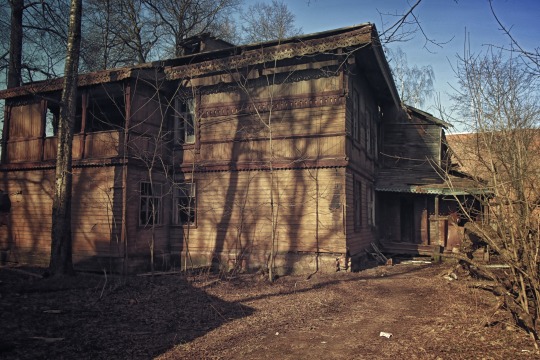

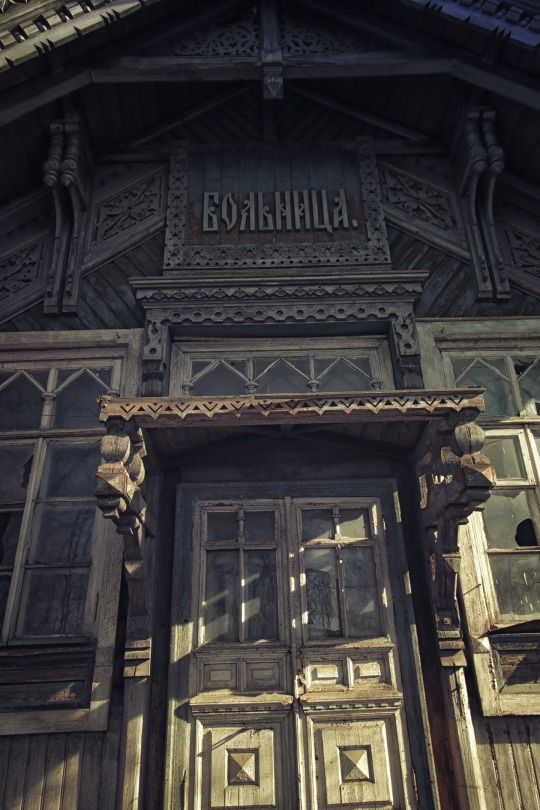


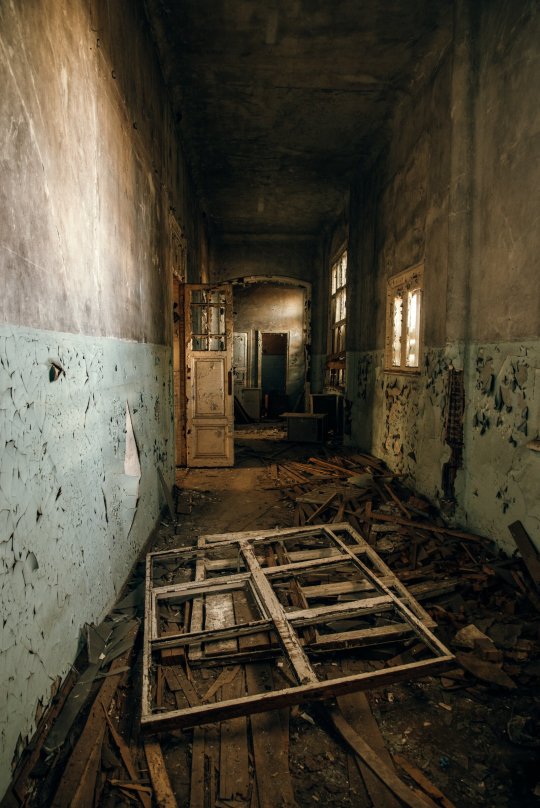

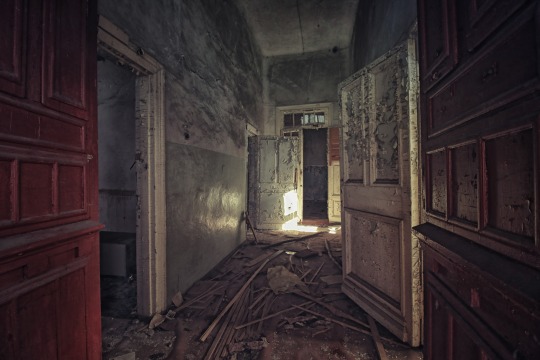

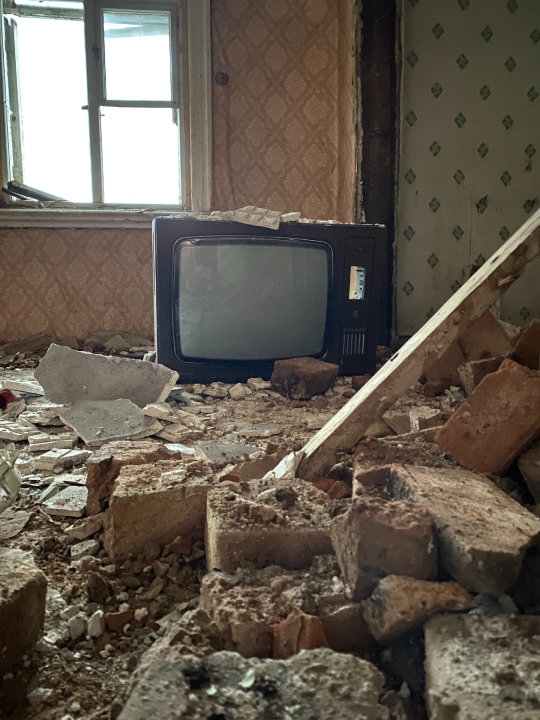






Заброшенная больница судорабочих в Рыбинске.
Ансамбль деревянных зданий расположен на левом берегу Волги на Бурлацкой улице, и скромно стоит �� тени лип. С дороги хорошо виден главный корпус с надписью «Больница». Улица не случайно называется Бурлацкая, а на набережной Рыбинска стоит памятник бурлаку. Когда-то Рыбинск был негласной столицей бурлаков, профессии тяжелой и теперь давно забытой. Каждый год тысячи бурлаков стекались в город в дореволюционные годы.
Больница появилась в 1880 году. Первый вклад сделал купец А.Ф. Фролов, отдав под больницу свою землю, за ним и другие горожане пожертвовали деньги на строительство лечебницы. Вскоре были построены первые здания. Весь ансамбль больницы построен в неорусском стиле. Исполнение вызывает уважение мастерством обращения с деревом. Обшивка доской выполнена поперек, вдоль и ёлочкой, красив деревянный, резной на просвет фриз, изящная обналичка, детали выноса крыши, сохранилась мелкая расстекловка окон, филенчатые двери.Вообще, удивительно, что все эти деревянные постройки сохранились до сих пор и на территории больницы не было не одного пожара.
Врачи здесь принимали больных только во время навигации, лечение было бесплатным.Бурлаки и другой рабочий люд могли получить медицинскую помощь, постель, еду и приличное одеяние. Профиль больница сохранила и в советские времена. Сюда обращались речники и жители левого берега Волги. В 90-е жизнь в больнице начала угасать. Закрылся хирургический корпус, уехали врачи. Двери пустующих зданий заколотили, охранять ветшающие памятники культурного наследия оставили старенького сторожа.В 1993 году все здания больницы судорабочих были признаны выявленными памятниками культурного наследия.
Следить за сохранностью имущества сейчас неком��, всё активно разрушается и приходит в упадок.Здания производят удручающее впечатление. Стекла в окнах разбиты, крыши сломаны, двери выбиты. В помещениях разбросаны документы. Памятник культуры, построенный рыбинцами, пережил падение империи и 70 лет советской власти. Теперь старой больнице самой нужна забота и лечение, иначе уникальный памятник исчезнет навсегда.
An abandoned hospital for ship workers in Rybinsk.
The ensemble of wooden buildings is located on the left bank of the Volga on Burlatskaya Street, and stands modestly in the shade of lime trees. The main building with the inscription "Hospital" is clearly visible from the road. It is no coincidence that the street is called Burlatskaya, and there is a monument to a boatman on the Rybinsk embankment. Once Rybinsk was the unspoken capital of boatmen, a difficult profession and now long forgotten. Every year thousands of boatmen flocked to the city in the pre-revolutionary years.
The hospital appeared in 1880. The first contribution was made by the merchant A.F. Frolov, who gave his land for the hospital, followed by other townspeople who donated money for the construction of the hospital. Soon the first buildings were built. The entire ensemble of the hospital is built in the neo-Russian style. The execution is respected by the skill of handling wood. The board covering is made across, along and with a herringbone pattern, a beautiful wooden frieze carved into the lumen, elegant cashing, details of the roof removal, small glazing of windows, paneled doors have been preserved.In general, it is surprising that all these wooden buildings have survived to this day and there has not been more than one fire on the territory of the hospital.
Doctors here took patients only during navigation, treatment was free.Boatmen and other working people could receive medical care, a bed, food and decent clothing. The hospital maintained its profile even in Soviet times. Rivermen and residents of the left bank of the Volga applied here. In the 90s, life in the hospital began to fade. The surgical building was closed, the doctors left. The doors of empty buildings were boarded up, and an old watchman was left to guard the dilapidated monuments of cultural heritage.In 1993, all the buildings of the Shipbuilders Hospital were recognized as identified cultural heritage monuments.
There is no one to monitor the safety of property now, everything is actively being destroyed and falling into disrepair.The buildings make a depressing impression. The glass in the windows is broken, the roofs are broken, the doors are knocked out. Documents are scattered in the rooms. The cultural monument built by the Rybintsy survived the fall of the empire and 70 years of Soviet rule. Now the old hospital itself needs care and treatment, otherwise the unique monument will disappear forever.
Источник:://rblogger.ru/2015/12/05/bolnitsa-v-ryibinske/,/vk.com/ wall-24572207_3398,//dzen.ru/a/ YL4FQxs_XCImk2Gs ,/dzen.ru /a/ X8ovW3iO2nXHM3rn.
#Россия#Рыбинск#история#Заброшка#Заброшенное#заброшенные места#больница#деревянное зодчество#неорусский стиль#природа#фотография#Russia#Rybinsk#history#abandoned#Architecture#hospital#wooden architecture#neo-Russian style#abandonedplaces#abandonedbuilding#nature#abandoned photography#lost places#lost in time#photography
310 notes
·
View notes
Text
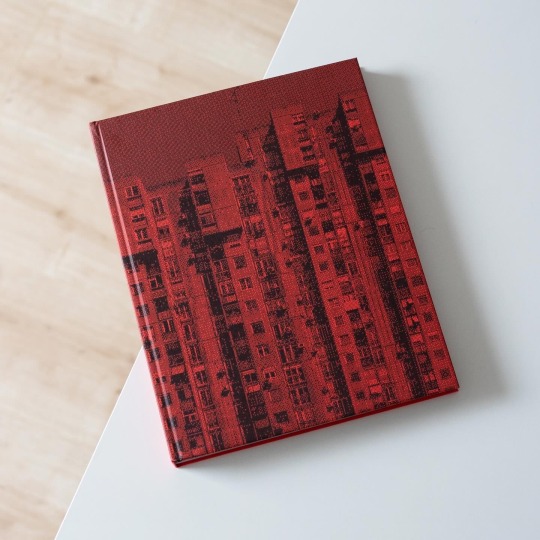
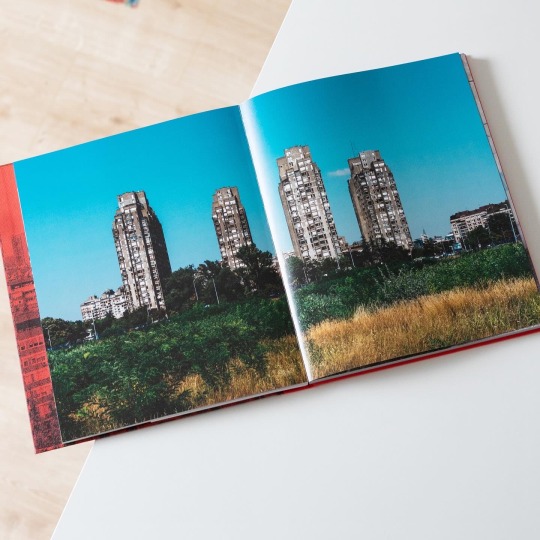
On the left bank of the Sava River and opposite the old town lies Novi Beograd, New Belgrade, the Serbian capital’s fastest growing municipality. It is a planned city and today’s inhabitants and businesses benefit from its rather modern infrastructure, a distinctive advantage over the old town. Novi Beograd’s construction began in 1948 but especially during 1960s and 1970s the municipality grew and numerous housing blocks and public buildings were erected. Because of these Novi Beograd in recent years has become something of a brutalist icon that is roaming social media platforms but is simultaneously subject to great change due to permanent new construction.
But while most photographers focus on the undeniable appeal of the architecture, Norwegian Marius Svaleng Andresen takes a closer look at the intersection of architecture and everyday life and the architecture in relation to the individual. In his book „Life in the New“, published last years by Kerber Verlag, Andresen explores the actual life going on inside, outside and in between the architecture: in view of the little stories of life the monumental architecture recedes into the background and becomes the stage of day-to-day life. People peeking out from behind the curtain, old men playing cards, a woman cleaning her windows and children running around, all of them populate Andresen’s photographs and bring up the question of what it is actually like to live in Novi Beograd. Apparently the photographer, who is also a journalist, asked himself this question too and met with 12 individuals who tell their own story of living in New Belgrade: there is Mirjana, the widow of a former military airport commander, who has been living in Novi Beograd for more than 50 years and at first didn’t really like it. And there is also Filip, the dog loving graphic designer and rapper, who philosophizes about the stepped volumes of the blocks and how they symbolize his daily struggle to reach the top.
In tandem with his sensible photographs Andersen provides an unusual, more humane portrait of Novi Beograd that is both visually stunning and emotionally touching. A warmly recommended read!
#marius svaleng andresen#architecture#serbia#novi beograd#belgrade#architectural photography#photo book#kerber verlag#book
41 notes
·
View notes
Note
What's the itinerary? 👀
Hi, Anon! Happy to share.
My dream American Revolution trip itinerary, just including my must-sees, and a rough idea of transportation (still working on food stops and slipping in other points of interest):
Day 1:
Early morning flight to Boston, MA
Stay in Boston for 3 nights, 4 days
Rental car for Day 2 and 3
Boston Massacre Site
Boston Tea Party Ships & Museum
Bunker Hill Museum and Monument
Old North Church & Historic Site
Day 2:
Paul Revere House
Lexington Battle Green Tour, Lexington MA
Drive from Boston
Old North Bridge, Concord MA
Drive from Lexington
Day 3:
Adams National Historic Park, Quincy MA
Drive from Boston
General Nathaniel Greene Homestead, Coventry RI
Drive from Adams NHP
Day 4:
Early morning train/bus to Albany, NY
Stay in Albany 2 nights, 3 days
Rental car for Day 4 and 5
Saratoga National Historical Park, Stillwater NY
Drive from Albany
Fort Ticonderoga, Ticonderoga NY
Drive from Saratoga NHP
Day 5:
Schuyler Mansion tour
Washington’s Headquarters State Historic Site, Newbrugh NY
Drive from Albany
John Jay Homestead, Katonah NY
Drive from Washington Headquarters Newbrugh
Day 6:
Early morning train from Albany to New York City, NY
Stay in New York City for 4 nights, 5 days
Hamilton Grange National Memorial
Morris-Jumel Mansion
Day 7:
City Hall Park
Federal Hall
Fraunces Tavern Museum
Trinity Church & Cemetary
Day 8:
Museum of the City of New York
The Metropolitan Museum of Art
Day 9:
Van Cortlandt House Museum
Central Park
New York Historical Society Museum & Library
Weehawken Dueling Grounds/Hamilton Park, Weehawken, NJ
Take ferry to and from
Day 10:
Train/bus to Princeton, NJ
Stay in Princeton 2 nights, 3 days
Rental car for Day 11
Princeton Battlefield State Park
Day 11:
Monmouth Battlefield State Park, Manalapan, NJ
Drive from Princeton
Morristown National Historical Park, Morristown NJ (Includes: Ford Mansion/Washington’s Headquarters, Schuyler-Hamilton House, Jockey Hollow)
Drive from Monmouth Battlefield Park
Day 12:
Early train/bus to Trenton, NJ
Old Barracks Museum
Washington Crossing Park, Washington Crossing, PA
Train/bus from Trenton
Train/Bus from Washington Crossing to Philadelphia PA
Stay in Philadelphia 3 nights, 4 days
Rental car for Day 15 and 16
Day 13:
Independence Hall
Liberty Bell Center
First Bank of the United States
Carpenter’s Hall
Day 14:
Museum of the American Revolution
Elfreth’s Alley Museum
Day 15:
Valley Forge National Historical Park
Drive from Philadelphia
Moland House (Washington Headquarters), Warwick Township PA
Drive from Valley Forge NHP
Peter Wentz Farmstead (Washington Headquarters), Lansdale PA
Drive from Moland House
Day 16:
Cliveden of the National Trust (Chew House)
Drive from Philadelphia
Brandywine Battlefield (park), Chadds Ford PA
Drive from Cliveden
Afternoon or evening train from Philadelphia to Alexandria, VA
Stay in Alexandria for 2 nights, 3 days
Rental car for Day 18
Day 17:
George Washington’s Mount Vernon
Train/bus from Alexandria, VA
National Archives Museum, Washington DC
Train/bus from Alexandria, VA
Day 18:
James Madison’s Montpelier, Montpelier Station, VA
Drive from Alexandria, VA
Evening train from Alexandria to Williamsburg, VA
Stay in Williamsburg 2 nights
Day 19:
Colonial Williamsburg
Day 20:
Yorktown Battlefield
American Revolution Museum at Yorktown
Train/bus/taxi from Williamsburg
Day 21:
Fly from Williamsburg to Charleston, SC
Stay in Charleston for 4 nights, 5 days
Rental car for Days 22-24
South Carolina Historical Society Museum
Day 22:
Savannah History Museum, Savannah GA
Battlefield Park Heritage Center, Savannah GA
Drive from Charleston
Day 23:
Cowpens National Battlefield, Cowpens SC
Drive from Charleston
Eutaw Springs Battlefield Park, Eutawville SC
Drive from Cowpens
Day 24:
Magnolia Plantation and Gardens
Mempkin Abbey (site of Laurens family graves)
Day 25:
Fly home from Charleston SC
#my real challenge is finding someone to go with me#fun part about being visually impaired is you can’t legally drive#amrev#trips#road trip#the american revolution#american revolutionary war#new england#dream travel#traveling#18th century history
10 notes
·
View notes
Text
Djenné Mosque, also known as the Grand Mosque of Djenné, is located in the city of Djenné in Mali, West Africa. It is one of the most famous examples of Sudanese architecture and it is considered one of the wonders of Africa.
Via @prince_edja
Here is some key information about the Djenné Mosque:
History: The mosque was first built in the 13th century, but the current structure dates back mainly to the early 20th century. It was built on the site of an old mosque dating back to the 12th century.
Architecture: The Djenné mosque is built of a bench, a mixture of mud and vegetable fibers. The structure is supported by wooden pillars and is coated with earth-coated. The mosque is famous for its distinctive architecture, pyramid-shaped minarets and massive appearance.
Dimensions: The mosque is about 75 meters long, 65 meters wide and can accommodate up to 3,000 believers. It is often considered the largest banking structure in the world.
Festival: Every year, the Djenné Mosque is the focal point of the Festival of Masks, a traditional celebration that attracts thousands of visitors. During the festival, the mosque is being renovated by the local community.
World Heritage Status: Due to its exceptional historical and architectural value, the Mosque of Djenné was inscribed on the UNESCO World Heritage List in 1988. She is considered a symbol of African cultural heritage.
Maintenance: Due to the materials used in its construction, the Djenné mosque requires regular maintenance. Every year, after the rainy season, the local community organizes a party called "crepissage" in which the clay is reapplied on the mosque walls.
The Djenné mosque is an emblematic monument of Africa and an important place of worship for the local community. It is also a major tourist attraction, attracting visitors from all over the world.
mali #mopti #djenne #tombouctou #afrique #africa
10 notes
·
View notes
Text
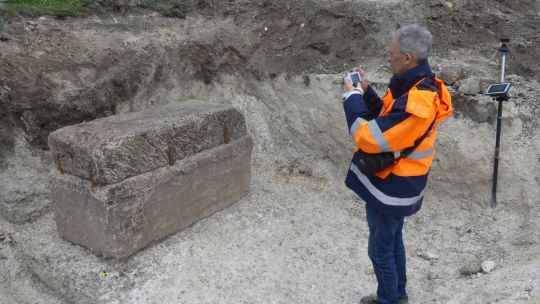
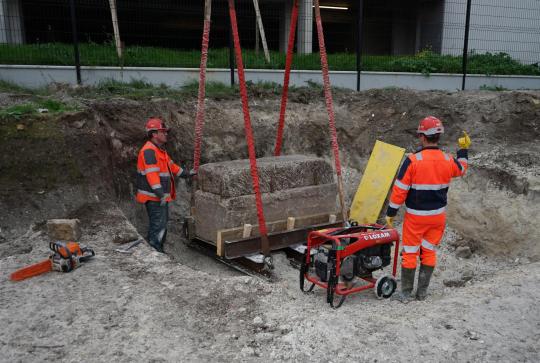
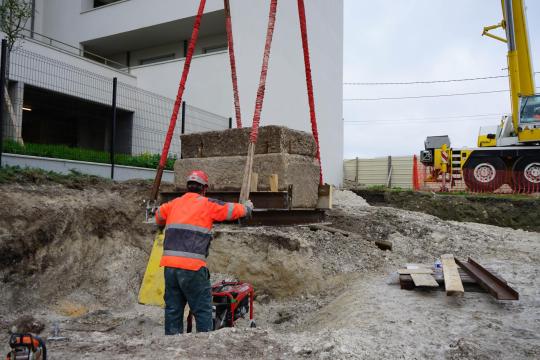
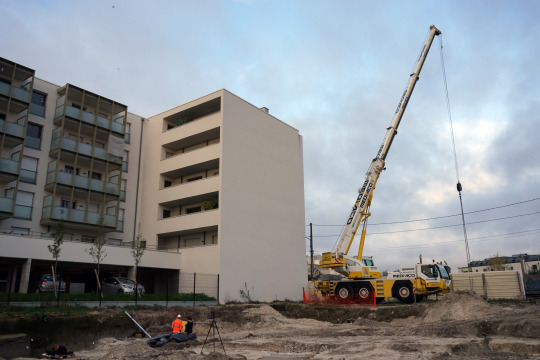
1,800-Year-Old Roman Sarcophagus Unearthed in France
Archaeologists excavating an ancient necropolis have unearthed a Roman-era sarcophagus containing the remains of a second-century woman, who was buried with oil lamps and accessories.
Archaeologists excavating an ancient necropolis in northeastern France have discovered an unlooted, unopened Roman-era sarcophagus dating to the second century A.D. The tomb likely holds the remains of an elite woman, archaeologists said.
The rough limestone sarcophagus was sealed shut with eight iron clasps, and its contents were hidden beneath a thick stone lid weighing 1,700 pounds (770 kilograms), according to a translated statement from the French National Institute of Preventive Archaeological Research (INRAP). To glimpse what lay inside, archaeologists X-rayed the sarcophagus and then inserted an endoscopic camera, which revealed a human skeleton and various grave goods.
"It's quite exceptional, it's the first time we've found a tomb that is intact and has not been looted," Agnès Balmelle, assistant scientific and technical director at INRAP, told the French newspaper Le Parisien.
The woman's skeleton was surrounded by beauty accessories — including a small mirror, an amber ring and a comb — intended to accompany the body into the afterlife. Such a monumental tomb suggests the woman, who was around 40 years old when she died, held a "special status," Balmelle said.
"The skeleton occupied the entire space inside the 1.53-meter [5-foot] tank," Balmelle added, leaving just enough room for the accessories, as well as four oil lamps and two glass vials that may have held scented oils.
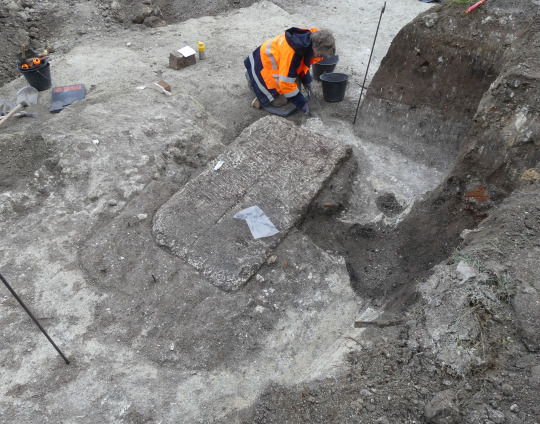
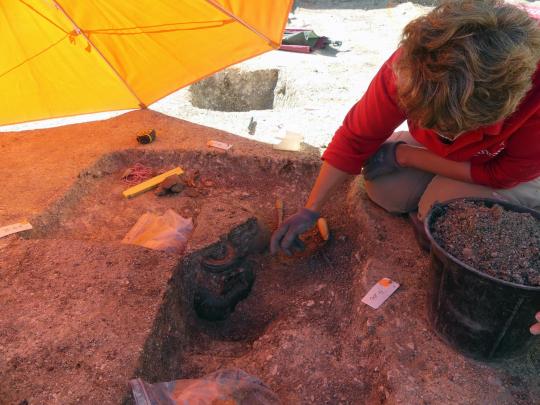
Archaeologists discovered the sarcophagus while excavating an ancient necropolis sprawling over 13,000 square feet (1,200 square meters) in the northeastern French city of Reims. During the second century, Reims, then known as Durocortorum, was one of the largest cities in the Roman Empire and the capital of Belgic Gaul — a province in northeastern Roman Gaul that included parts of modern-day France, Belgium, Luxembourg, the Netherlands and Germany.
The newly unearthed necropolis is one of several that extended beyond the city's fortifications and along seven main thoroughfares leading to other Roman Gallic metropolises, including Lutetia (now Paris) and Lugdunum (modern-day Lyon). Since the first of these cemeteries came to light in the second half of the 19th century, archaeologists have excavated 5,000 ancient burials in Reims, according to the statement.
Most of these burials were looted over the centuries, however, and the grave goods that survived were largely destroyed during World War I, when the museum they were housed in was bombed.


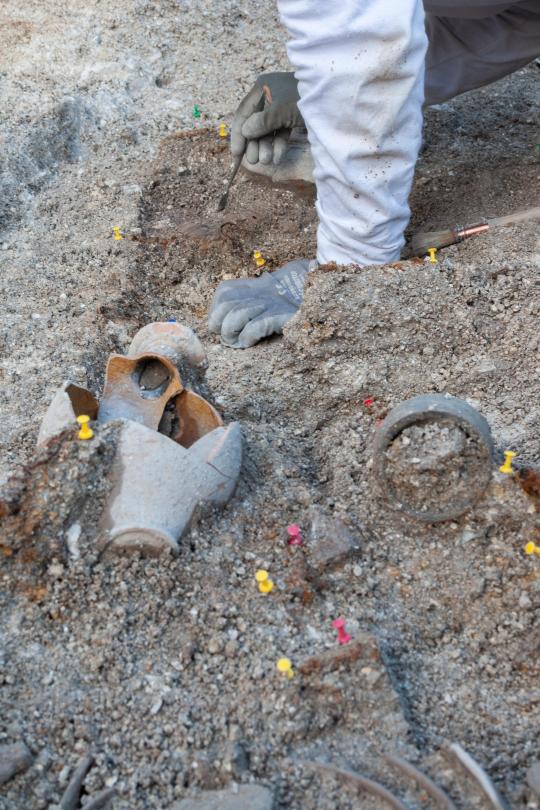
The sealed sarcophagus is the first unlooted tomb of its kind discovered in a former Gallo-Roman town, according to the statement. In the area surrounding it, archaeologists found another 20 buried and cremated human remains laid to rest over several centuries.
These remains will be added to a growing bank of samples salvaged from Reims' necropolises. Scientists hope that by comparing DNA from the skeleton in the sarcophagus to some of these samples, they may be able to determine whether the woman belonged to a local or foreign elite.
By Sascha Pare.
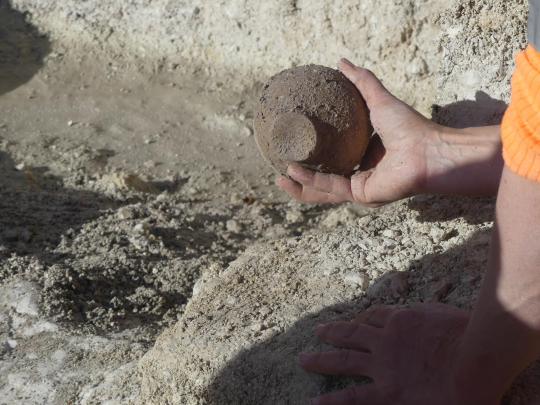
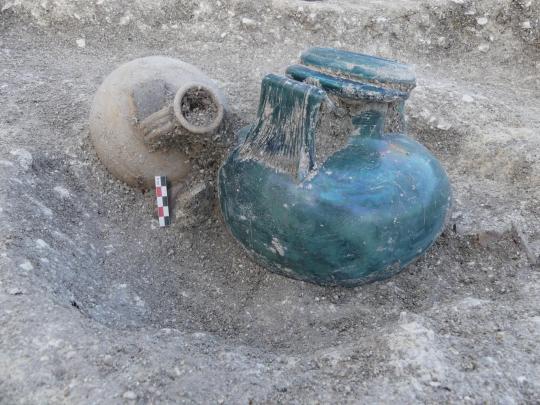
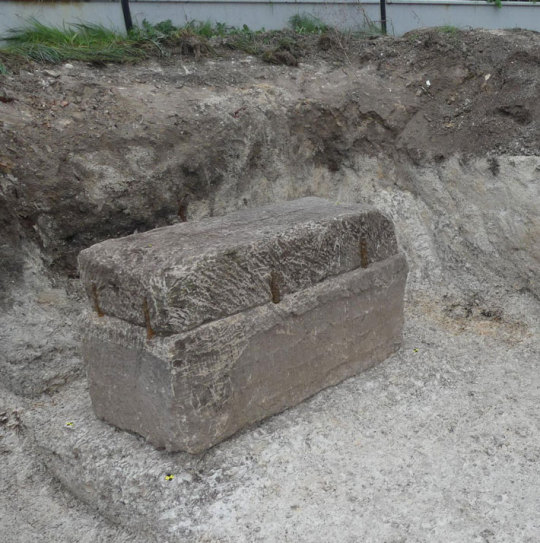
#1800-Year-Old Roman Sarcophagus Unearthed in France#Reims France#Durocortorum#ancient tomb#ancient grave#ancient sarcophagus#ancient artifacts#archeology#archeolgst#history#history news#ancient history#ancient culture#ancient civilizations#roman history#roman empire#roman art
30 notes
·
View notes
Text

Bladerunner (1982), Ridley Scott
There’s a lot to say about this movie, originally I wanted to post a screencap of the landscape and talk about how they made the miniature city, but whatever, this caught my eye and I wanted to write about the imagery of the Tyrell Headquarters. My first thought looking at this monument was that there’s no possible way they needed this much space. Tyrell is a tech firm, banks don’t even use buildings this big. Then we look at the shape. I don’t need a masters in English to tell you that this takes after the great pyramids. It’s meant to evoke the grandeur of yesteryear’s godheads and convey to the viewer who the rules this world before they're even introduced to its residents. If I can fully get into professor mode, I think the plateau shape is there for a reason. It’s meant to highlight the finer difference between the new system and the old. Whereas in ancient times there was A king who ruled over the land, it’s now more conceptual. The idea of corporate authority, without divine mandate or a precise origin.
And that’s cyberpunk. Neon signs and japanese people aren’t inherently sci fi, they’re just tools for conveying the hollowness of the regime. In a way, I always kind of feel that you can see the groundwork for this kind of setting all the way back in Philip K. Dick’s first major work, Man in the high castle. In one of the many sections of the book that peals away from the narrative to give a more cerebral view of man, he writes about how fascism lacks a fundamental material core that it cares about. Rather, it puts its emphasis on the conceptual. “Their view; it is cosmic. Not of a man here, a child there, but an abstraction: race, land. Volk. Land. Blut. Ehre. Not of honorable men but of Ehre itself, honor; the abstract is real, the actual is invisible to them. Die Güte, but not good men, this good man.” In that same sense, I think that’s the end result of the kind of nihilistic consumerism we see in a lot of cyberpunk. Thought the emphasis is turned way from the fascistic worship of the conceptual race, and more on the vague idea of ownership and capital. The Tyrell building is that. When we erect enormous edifices to ethereal entities existing in enmity to existential ideals.
2 notes
·
View notes
Text

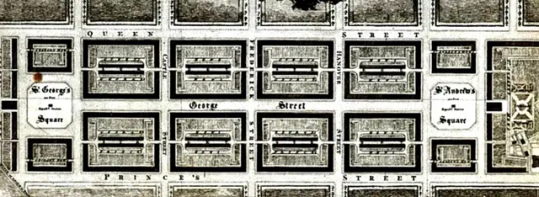
The Architect James Craig was born on October 31st 1739.
As you will know dates are not always easy to pin down in may instances, usually it can vary by a few days either way, with James Craig however it is a few years, here is why;
James Craig’s birth date has traditionally given as 1744, as his baptism is recorded in parish register as 13th November 1744. However, more recent research has shown that his birth date was 31st October 1739, as recorded in the registers of George Watson’s Hospital School, where Craig was educated. As well as his date of birth, the records show he entered the school in 1748, and left in 1755. The 1744 date must therefore be incorrect, as it would mean he started school aged four, and left aged eleven.
The fact that he attended a charitable institution suggests that Craig’s father was not a wealthy man. In 1755 started work for Patrick Jamieson, a mason and deacon of the Incorporation of Wrights and Masons. Unlike some of his contemporaries he did not have the means to make the traditional Grand Tour, nor could he afford to set up business as a master mason.
Craig first came to be noticed when, 1763 he submitted a proposal to build a bridge across the drained Nor’ Loch to encourage the development of the land belonging to the city to the north. He was a good draughtsman, in July that same year he was employed to draw a plan and elevation of the proposed North Bridge in Edinburgh, which seems to have been designed by George Fraser. The purpose of this plan was to attract tenders. It was published in the ‘Scots Magazine’. Also that year Craig was the winner of the competition for laying out the New Town of Edinburgh. Seven entries were received and Craig’s plan was judged to be the best.
A lot of people cite Craig for designing the the buildings in the New Town, this is wrong, he merely designed the street layouts, more or less as we know them today, one of the first buildings, Dundas House, was designed by William Chambers and is now the Royal Bank of Scotland HQ, well the registered office for the business anyway. The other most noted architect was Robert Adam.
Back to Craig, the only buildings he seems to have designed in the whole development were at St James Square, which isn’t even classified as the New Town so he seems to have been relegated to a bit player. The footpath linking the end of Princes Street/Leith Street to what is now Multrees Walk is named James Craig Walk in his honour.
Craig never achieved the status of the likes of Adam or Chambers and wasn’t a good businessman, whereas not being in poverty, he did die in what was considered a fair bit of debt when he passed away unmarried in the West Bow, Old own on 23 June 1795, so he probably could not afford to live in the streets he helped form. His grave has a simple marker in Greyfriars Kirkyard. Due to complex bans on monuments in Greyfriars’ churchyard through the years it was actually unmarked until the 1930’s.
6 notes
·
View notes
Text
“Mumbai by Bus: Top October Destinations for an Unforgettable Journey”
Exploring Mumbai in October is a wonderful experience, and travelling around Mumbai by bus is a great way to soak in the city’s charm without breaking the bank. The post-monsoon weather is cool and pleasant, making it the best time to explore tourist places in Mumbai. Whether you’re a local resident or visiting for the first time, this list of the best places to visit in Mumbai by bus will help you plan an exciting day out. Opt for a local bus or even a minibus from TransRentals for a more personalized trip to these iconic spots!
1. Marine Drive

Location: South Mumbai
Famous For: Scenic coastline, stunning sunsets, and night views.
Things to Do: Take a leisurely stroll along the promenade, enjoy the cool sea breeze, or relax on the parapet as the city lights up in the evening.
Trip Duration: 1–2 hours
Budget: Minimal, as it’s a free attraction.
Must Try Foods: Enjoy some Bhel Puri, Pav Bhaji, or refreshing coconut water from the street vendors.
Marine Drive, also known as the “Queen’s Necklace,” is one of the best places to visit in Mumbai. Stretching for about 3.6 km along the Arabian Sea, it offers breathtaking views of the city’s skyline. Taking a bus to Marine Drive is a great way to enjoy the coastal route. During October, the cool breeze and clear skies make it perfect for an evening stroll, capturing the beauty of the iconic curve of the promenade. This tourist places in Mumbai comes alive at sunset, making it a must-visit spot when exploring Mumbai by bus.
2. Gateway of India

Location: Apollo Bunder, Colaba
Famous For: Historical landmark, impressive architecture, and beautiful sea views.
Things to Do: Take a ferry to Elephanta Caves, capture photos of the Gateway’s grand structure, or just sit back and observe the lively atmosphere around this iconic spot.
Trip Duration: 2–3 hours
Budget: Free for the monument; ferry charges vary.
Must Try Foods: Savor some authentic Bombay Sandwich and cutting chai nearby.
The Gateway of India is a prime example of Mumbai’s colonial past and one of the best places to visit in Mumbai. It stands majestically overlooking the Arabian Sea and offers a glimpse into the city’s rich history. Taking a bus or minibus to Colaba is convenient, giving you a chance to explore nearby attractions like the Colaba Causeway and the historic Taj Mahal Palace Hotel. October is a great time to visit as the post-monsoon weather is pleasant, and the crowds are relatively less, making it one of the best places to visit in October.
3. Sanjay Gandhi National Park

Location: Borivali East
Famous For: Rich biodiversity, Kanheri Caves, and nature trails.
Things to Do: Take a toy train ride, explore the ancient Kanheri Caves, go on a nature walk, or enjoy a serene boating experience at the park’s lake.
Trip Duration: 4–5 hours
Budget: Entry fee of ₹53 for adults and additional charges for the toy train and boating.
Must Try Foods: Bring your own picnic or enjoy some light snacks available at the park’s entrance.
If you’re a nature enthusiast, Sanjay Gandhi National Park is a top destination to visit by bus. This vast green oasis is home to diverse flora and fauna, making it one of the best places to visit in Mumbai for nature lovers. A minibus journey through Borivali brings you to the park’s gates, where you can explore the lush trails and spot wildlife. October is the best time to visit as the park is refreshed by the monsoon rains, and the greenery is at its peak. The ancient Kanheri Caves within the park add a touch of history to your adventure, making this a perfect tourist places in Mumbai.
4. Worli Sea Face

Location: Worli, Mumbai
Famous For: Panoramic views of the Arabian Sea and the Bandra-Worli Sea Link.
Things to Do: Enjoy a peaceful walk along the promenade, capture photos of the stunning sea link, or relax at one of the seating areas while watching the waves crash.
Trip Duration: 1–2 hours
Budget: Free
Must Try Foods: Relish some Chana Chaat or Ice Gola from the local vendors.
Worli Sea Face is a serene location that offers a peaceful escape from the city’s hustle. Known for its stunning views of the Bandra-Worli Sea Link, it’s a favorite among Mumbaikars and tourists alike. Arriving at this spot by bus lets you enjoy the changing skyline of Mumbai as you move through bustling neighborhoods. October’s clear skies make this a perfect month to capture some amazing photos. It’s undoubtedly one of the best places to visit in Mumbai to relax and soak in the beauty of the sea.
5. Bandra Bandstand

Location: Bandra West
Famous For: Celebrity residences, Mount Mary Church, and sea views.
Things to Do: Walk along the promenade, spot Bollywood stars’ homes, visit the iconic Mount Mary Church, and capture sunset views by the Bandra Fort.
Trip Duration: 2–3 hours
Budget: Free
Must Try Foods: Indulge in some Vada Pav and Bun Maska from the famous cafes and street food stalls around Bandra.
Bandra Bandstand is a lively spot filled with people enjoying the cool sea breeze and panoramic views of the Arabian Sea. It’s also famous for being home to some of Bollywood’s biggest stars. Arriving by bus allows you to explore Bandra’s trendy streets and vibrant culture. October’s mild weather makes it one of the best places to visit in October if you want to experience the celebrity charm of Mumbai.
6. Chhatrapati Shivaji Maharaj Vastu Sangrahalaya (CSMVS)

Location: Fort, South Mumbai
Famous For: Extensive collection of historical artifacts, art, and sculptures.
Things to Do: Explore exhibits on Indian history, art, and culture, and admire the Indo-Saracenic architecture of the museum building.
Trip Duration: 2–3 hours
Budget: ₹70 for Indian citizens; ₹500 for foreign nationals.
Must Try Foods: Visit the museum café for some quick bites and coffee.
This premier museum is a treasure trove of history and culture, making it one of the best places to visit in Mumbai. A visit to CSMVS by bus gives you a chance to explore the historic Fort area. With its extensive collection of sculptures, textiles, and artifacts, it’s an excellent destination for history enthusiasts. The post-monsoon climate in October ensures that both the museum and its gardens are delightful to explore.
7. Juhu Beach

Location: Juhu, Mumbai
Famous For: Long sandy beach, street food, and family-friendly atmosphere.
Things to Do: Take a stroll on the beach, enjoy horse rides, or try famous Mumbai street food like Pani Puri, Sev Puri, and Pav Bhaji.
Trip Duration: 2–3 hours
Budget: Free entry; food costs vary.
Must Try Foods: Don’t miss the delicious Gola and Mumbai-style Bhel.
Juhu Beach is one of the most popular tourist places in Mumbai. Taking a minibus or bus to Juhu allows you to experience the bustling streets of the suburbs. The beach is famous for its lively atmosphere, and October’s cool breeze makes it perfect for an evening outing. Enjoy the best street food, soak in the sunset, and watch the locals play cricket or fly kites.
Exploring Mumbai by bus not only saves money but also offers a chance to see the city through a local’s eyes. From historic landmarks to serene sea views, these best places to visit in Mumbai are ideal for creating unforgettable memories in October!
Travel Tips for Exploring Mumbai by Bus in October
Start Early: Traffic in Mumbai can get heavy, so start your journey early to make the most of your day.
Use Local Apps: Use apps like BEST Bus Guide or M-indicator to find the right bus routes and schedules.
Carry Essentials: Keep a water bottle, sunscreen, and a hat handy as October can sometimes be sunny.
Plan Your Meals: Mumbai is known for its street food. Plan your meal stops accordingly to taste the local flavors.
Bus Fares: Local bus fares in Mumbai are quite affordable, ranging between ₹5 to ₹50 depending on the distance. Opt for an AC bus for a more comfortable journey.
Exploring Mumbai in October by bus allows you to experience the city’s unique charm, vibrant culture, and picturesquebeauty without breaking the bank. Plan your route, hop on a bus, and get ready for an unforgettable journey across Mumbai’s top destinations!
2 notes
·
View notes
Text
Flat Phryne in Buffalo!

Flat Phryne's adventures on the way to Miss Fisher Con in St. Paul continue. This week, she paid a visit to Buffalo, New York!
She checked in at the Hotel Lafayette. During it's prime, the Lafayette was one of the 15 finest hotels in the United States, boasting not only elevators, and hot and cold running water and a telephone in every room. Flat Phryne enjoyed her time there before heading out to see the sites.

Flat Phryne's first stop was Buffalo City Hall, one of the largest and tallest municipal buildings in the US. The Art Deco building, designed by Dietel, Wade and Jones, and featuring sculpture by Albert Steward, Rene Paul Chambellan and William Ehrich, was completed in 1931.
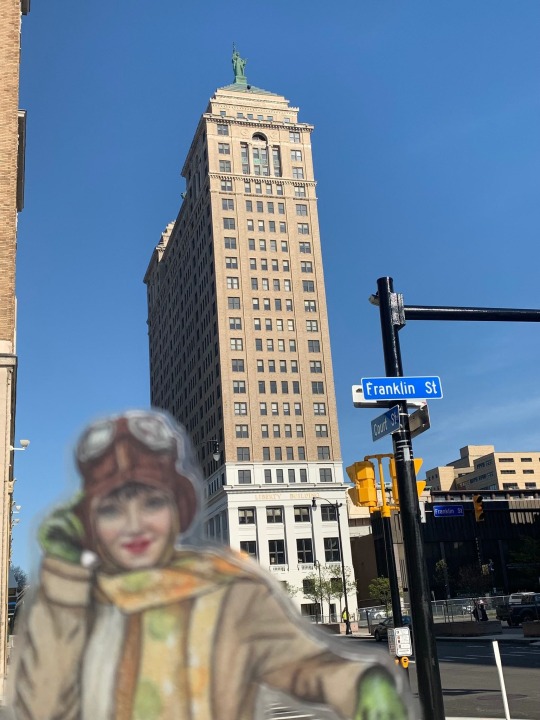
Next she made her way to the Liberty Building, built in 1925 and topped with replicas of the Statue of Liberty. She wanted to replicate Didier Pasquette's 2010 tightrope walk between the 2 rooftop statues, but it wasn't in the cards. Maybe next time!
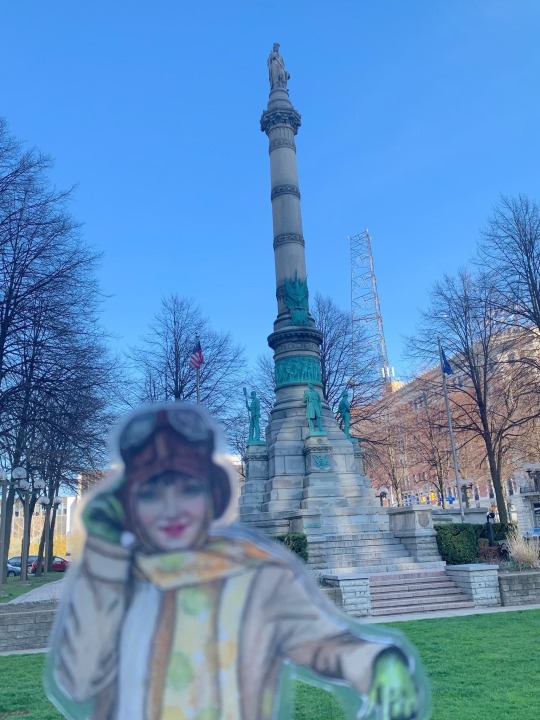
She then stopped by the Soldiers and Sailors Monument in Lafayette Park.
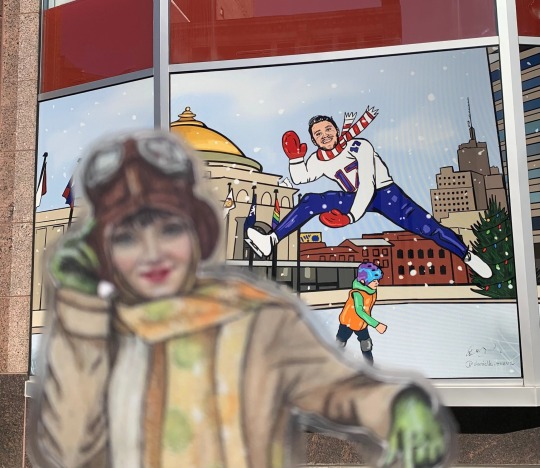
Phryne was keen to learn more about Josh Allen, the quarterback for the Buffalo Bills, though she prefers footie to American football.
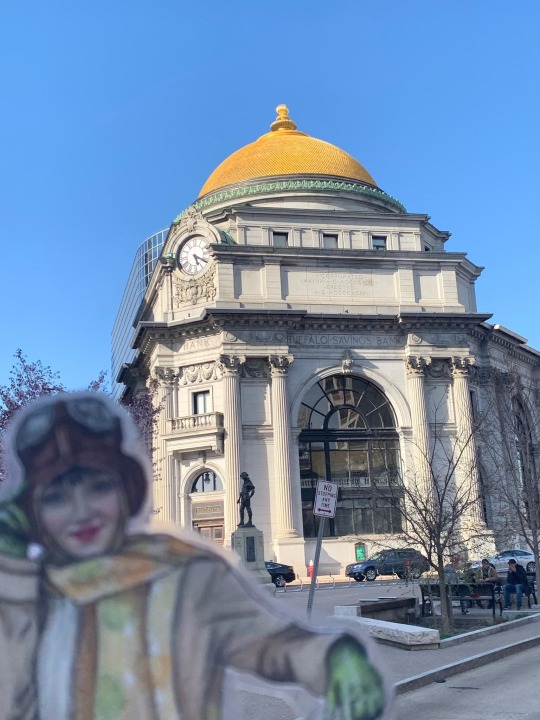
She made a quick stop to admire the Buffalo Savings Bank,
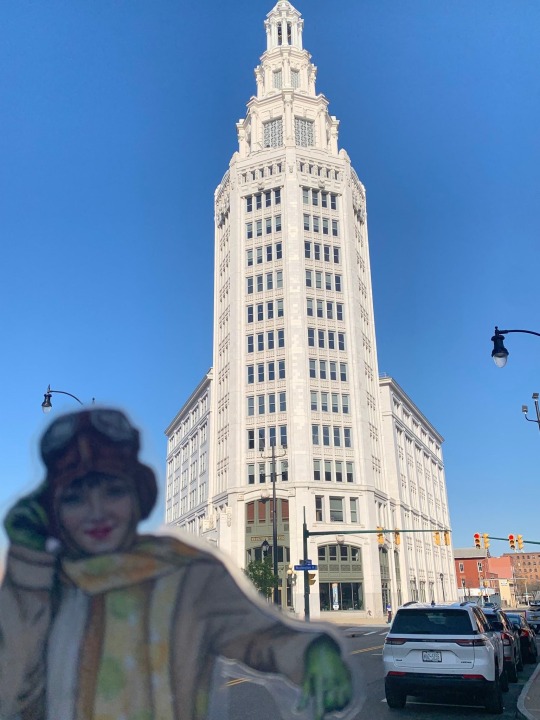
and the Electric Tower building,
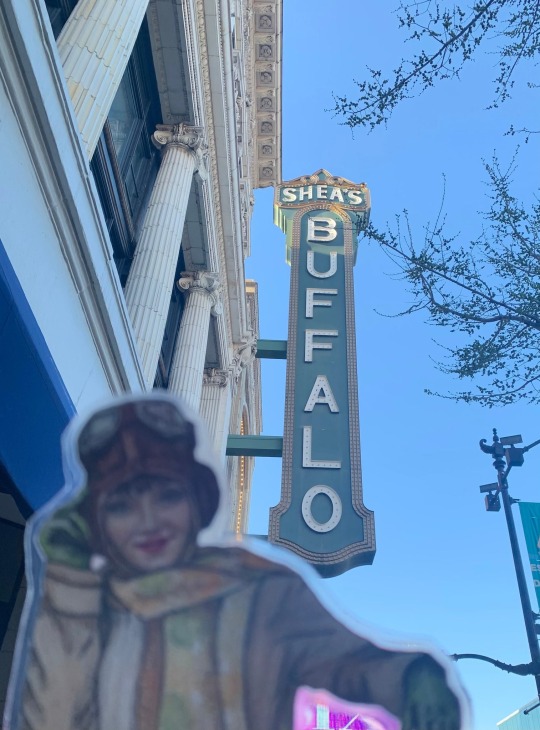
before taking in a picture and enjoying the Wurlitzer extravaganza at Shea's. The Mighty Wurlitzer organ at Shea's (and in the Capitol Theatre in Melbourne!) were made just north of Buffalo.

Today, the former Wurlitzer factory is home to a brewery, events, and an amazing chocolate factory.
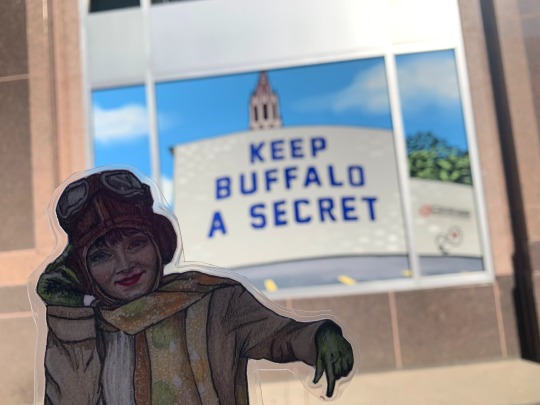
Where will Flat Phryne turn up next? Stay tuned!
#MissFisher
#MsFisher
#1920s
#1920sfashion
#1920sstyle
#1960s
#1960sfashion
#1960svintage
#1930s
#1930sfashion
#1930sstyle
#1930svintage
#shanghai
#melbourne
#mnhistory
#flapper
#phrynefisher
#adventuressescluboftheamericas
#adventuress
#stpaulmn
#stpaul
#saintpaul
#saintpaulmn
#saintpaulminnesota
#saintpaulhotel
#buffalo
#buffalony
#wurlitzer
#artdeco
#flatphryne
·
21 notes
·
View notes
Text
Court Sentence FCMB Branch Manager to 121 years in Prison for embezzling Customers Funds
FCMB is a leading financial institution in Nigeria has received a big shock of the year as one of its staff has been thrown to prison for fraud and embezzlement. Justice S. Odili at the Anambra State High Court in Onitsha, Anambra State, sentenced Mr Nwachukwu Placidus, a bank manager at First City Monument Bank FCMB, Onitsha Anambra State to 121 years in prison for embezzling N112 million from a…

View On WordPress
0 notes
Text
Day Trip to the Taj Mahal: A Journey into Timeless Beauty

Introduction
A visit to the Taj Mahal is an experience that etches itself into your memory forever. Known as the "Crown of Palaces," this iconic symbol of love and architectural brilliance attracts millions of visitors each year. Whether you're a history enthusiast, an architecture aficionado, or simply a traveler seeking beauty, a Day Trip to Taj Mahal. offers a rich and unforgettable experience.
Getting There
The Taj Mahal is located in Agra, a city in the northern Indian state of Uttar Pradesh. For those starting from Delhi, the fastest way to reach Agra is by train, with the Gatimaan Express being a popular choice. Alternatively, a car journey via the Yamuna Expressway can get you there in approximately three hours. Both options provide a convenient and scenic route to the historic city.####
Arrival in Agra
Upon arriving in Agra, it's best to head directly to the Taj Mahal to make the most of your day. The monument opens at sunrise, and visiting early helps you avoid the larger crowds and the midday heat. As you approach the gates, the anticipation builds, and the first glimpse of the Taj Mahal through the main entrance is nothing short of magical.
Exploring the Taj Mahal
Built by Mughal Emperor Shah Jahan in memory of his beloved wife Mumtaz Mahal, The Taj Mahal is a masterpiece of Mughal architecture. The white marble mausoleum, adorned with intricate carvings and precious stone inlays, stands majestically on the banks of the Yamuna River. As you walk through the meticulously landscaped gardens, the grandeur of the structure unfolds, revealing its symmetrical beauty and detailed craftsmanship.Take time to explore the main mausoleum, the mosque, and the guest house, all of which showcase the exquisite artistry of the period. Inside the mausoleum, the cenotaphs of Shah Jahan and Mumtaz Mahal lie surrounded by intricate marble screens, adding to the sense of reverence and solemnity.####
Photography Tips
Capturing the Taj Mahal in all its glory can be a photographer's delight. The soft morning light provides the perfect conditions for stunning photos. The classic reflection shot from the central pool is a must, but don't hesitate to explore different angles and perspectives. The Taj Mahal's beauty is such that every shot has the potential to be a masterpiece.
Lunch and Local Cuisine
After a morning spent at the Taj Mahal, head to one of Agra's many restaurants to enjoy a traditional Indian lunch. Agra is famous for its Mughlai cuisine, so be sure to try local dishes like kebabs, biryani, and petha, a sweet delicacy unique to the region.
Other Attractions in Agra
If time permits, consider visiting other historical sites in Agra. The Agra Fort, a UNESCO World Heritage Site, offers a fascinating glimpse into the city's rich history and provides stunning views of the Taj Mahal from a distance. Another notable site is the Tomb of Itimad-ud-Daulah, often referred to as the "Baby Taj," which prefigures many aspects of the Taj Mahal's design
Conclusion
A day trip to the Taj Mahal is more than just a visit to a historical monument; it's a journey into the heart of India’s cultural and architectural heritage. The awe-inspiring beauty of the Taj Mahal, combined with the rich history of Agra, makes for a truly enriching travel experience. Whether it's your first visit or a return trip, the allure of the Taj Mahal never fades, leaving you with memories that last a lifetime.
If you want Taj Mahal tours any India Tour contact us :--
India Day Trip
Call -- +91 81260 52755
Email id :-- [email protected]
Website :- www.indiadaytrip.com
WhatsApp :-- +91 81260 52755
#taj mahal tour#tajmahal tour by train#tajmahal day tour#tajmahal tour by car from delhi#taj mahal trip#taj mahal guide#agratour#agra#Day Trip to Taj Mahal#Golden Triangle T#delhi agra jaipur tour#golden triangle package#golden triangle holidays#india tourism#travel
3 notes
·
View notes
Text
by Oliver Wainright
The house was conceived as a monument to aspirations of Palestinian statehood, part memorial for what has been lost, part beacon for a possible future. As in Palladio’s original villa, which was built as a summer party house for a retired cleric, four grand salons lead from the central rotunda, although here they have been renamed after cities in historic Palestine.
There is Jerusalem-Hebron, which contains a library of almost 5,000 books, where a pair of antique French spiral staircases lead to an upper gallery of first editions and rare manuscripts. A 17th-century stone fireplace frames an iron hearth decorated with a crown, while a six-foot-long camera from Turkey stands next to photographs of Masri with former Palestine Liberation Organisation leader Yasser Arafat, to whom he was a close confidant, alongside pictures with Nelson Mandela and Pope John Paul II.
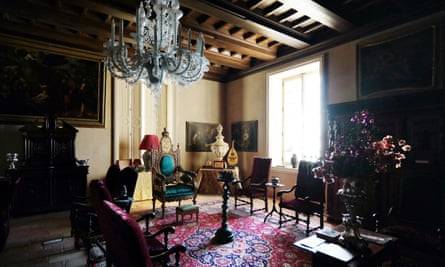
In his second living room, Haifa-Jaffa, stands a gold-plated throne that belonged to Khedive Ismail, the ruler of Egypt from 1863 to 1879, which Masri bought because the steamship on which he first sailed to America from Beirut was named the SS Khedive Ismail. The list goes on and it’s hard to keep up. The agile 84-year-old moves quickly from possession to priceless possession, like a keeper auditing the contents of his museum, taking phone calls in between recounting the booty of kings and emperors.
But the real meaning of the house, he says, is found on the floor below. Here, in a dusty series of rooms that have the forlorn air of an abandoned provincial museum, he has created a suite of educational displays. There is a room devoted to geology and the origins of life on Earth, followed by a small archaeological exhibition, and a wing dedicated to the history of the Palestinian struggle, interwoven with Masri’s personal biography, all depicted in a series of quaint murals.
Not bad for an "open-air prison." EY
6 notes
·
View notes
Text
Delhi on the Yamuna River
Delhi is India’s capital territory and officially known as the National Capital Territory of Delhi and sits on the banks of the Yamuna River. The city is home to the imposing Mughal-era Red Fort which is a symbol of India. The Mehrauli Archaeological Park is a forest park with lots of ruins of tombs, palaces, and colonial follies. As you enter the park the first monuments you see are the tombs…
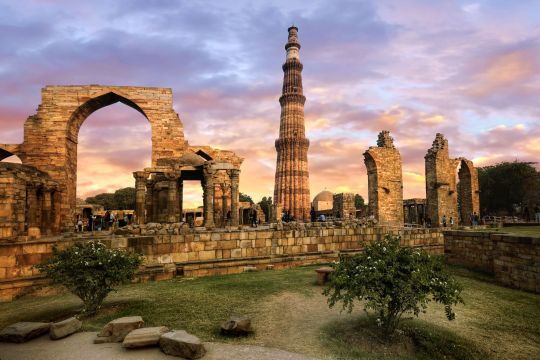
View On WordPress
4 notes
·
View notes
Text
Skylark, Chapter 1.
The Skylark sat upon an old boxcar adjusting the valves on her gas mask. The car lay on its side, decrepit and half rusted; a once important piece of infrastructure left to rot. It was quiet here, and the rain had stopped for now. What had once been a city and outpost now sagged and sunk. From here, on a turned over boxcar resting on an old loading station halfway up the old central tower, the Skylark had a vast view of the Zone which lay shortly beyond the old edge of the outpost. It had been of a pair; its twin lay inside the Zone, built by the Bastion to be a monument of human ingenuity. It had become a monument of hubris instead
It was not long until the rain started again. Today it fell as dust rain, dark grey drops which shattered on the ground. A boon of sorts. Not something you’d want to drink unfiltered, but better than the acid rains or the rare blood rains. The Skylark stayed for a while, trying to gauge how the zone was acting. The wind was faint today, so she strained her ears to listen. Then, with a huff, she rose to her feet and gathered up her things, hooking the gasmask onto her tool belt and slinging her rifle-spear across her back. She pulled up the hood of her raincoat and began the long climb down the tower.
Below the overpass at the foot of the tower hung the old propaganda posters of the bastion, boldly proclaiming that this outpost and its twin would herald humanity’s victory over the Zone. No-one had bothered to take them down in the thirty years since the tower in the zone fell. Humans needed something to find humour in, supposed the Skylark. And so the old boast still hung, half-sheltered from the elements. The skylark spat in the printed face of a now-dead king then continued onwards.
To the south, away from the tower and the zone, lay a hollowed-out factory district that served as the homes of the majority of those who’d ended up in the city. The Lark headed east instead, to the river that wound through the city. All the while, the dust rain poured down, forming rivulets of blackened water that trickled through the cracked streets before disappearing underground. There they would either throw themselves down the bellies of the stormdrains or they would join the river, that emerged from the city to the southeast, from where it wandered further, twisting and turning in a roar until it reached a coast somewhere that the Skylark didn’t know.
The path toward the banks of the river was circuitous. First was the old train station, which had once been the heart of the outpost. Even now a train would roll in every once in a while. It had been half a year since the last time. It was a crumbling wreck. Descending down the hillside was the old commercial district. In some places the rain shields had been stripped for the homes down south, leaving the concrete and steel exposed to wither away. Scarce thirty years had passed since this was a bustling, living, outpost. Now all that were left were skeletal ruins. Down further was the river.
When the dams broke it had washed through this place, leaving hollowed out ruins behind. The lark climbed in through the window of one of the grey concrete buildings and continued upward to the old roof-access. Beyond this building the streets were submerged under water; somewhere as shallow as a couple of feet, others several metres below the surface. And in some places the old street level had fallen away, leaving plunging depths for the river to throw itself into. The city predated the Bastion − way the old man by the old storm drain told it, it had been first built before the zones had formed. Before the world had first choked itself on hubris. And as the world choked, as the zones crawled into existence, this city had been one of the last holdouts. But thousands and thousands of years left their mark. Sometimes, in the depths of winter nights with bloodrain strangling the streets, the Lark thought she could hear the whispers of the old city, speaking in a voice that was not a voice at all.
The lark turned south, climbing across the old buildings and rickety paths through the dust rain. She kept an eye over the river as she clambered alongside it. It looked calm today. Upstream of the city lay the Zone. From deep in the maddened landscape the churning waters flowed. It brimmed with life, fish with shimmering scales, crustaceans with river moss growing out of their carapaces, trout with scales that every so often formed fractals, lobsters whose exoskeletons grew into thorny forests that formed moving shelters for smaller things. As the river moved out of the zone it carried its fruits along with it.
The river was the main source of food in the crumbling outpost. Upon the corner of the roof of an old building standing where three paths had once met, the Lark stopped. She waved to the rest of the hunting party, seated below on a wooden deck and preparing as the dust rain fell all about them. Including the Lark, there were five on the hunt. She was early: they wouldn’t leave for another half hour or so. “Lark,” said one of them in greeting, then asked how the river looked. “She’s peaceful today. Saw a flock of herons some two miles north however. Best be quiet.” Herons were bad news. Upon their stilt-like legs they prowled the river, hunting. They were not picky eaters.
The Lark’s job was simple: lookout. Keep an eye out for trouble, and one for prey. She’d clamber over the rickety paths that spanned the shoreward stretches of the river. Good eyes and steady feet. It was a good day for hunting, likely the best they would see in a while. All five of them spent their time preparing; checking harpoons, lacing boots and the like. They talked too, mostly of small things. One of the hunters, a one-eyed man in his forties, asked her how the zone had looked earlier. “It’s uneasy, I’d say. I don’t like the look of it. But I’d have to get to the north of the river to get a better listen.” The one-eyed man nodded at that. Then, after a couple more minutes of rain smattering down, he rose. The hunt was on.
The sturgeon thrashed as the harpoon pierced the bony plates of its flank. It was large – almost three metres long, the skylark estimated from her perch above. As the second harpoonist readied her speargun, the Lark looked north up the river. Here was a good sightline, even through the rain. A little more than a mile north she could see the outlines of the flock of herons she’d spied earlier. They had moved south under the hunt. It made the Lark uneasy. But the herons didn’t seem to have spotted them, so for now they were all right. With the third shot from a harpoonist’s speargun the sturgeon thrashed a last time as a harpoon pierced through one of its four eyes into the brain, then floated silently, held by the lines of the harpoons. It was a good catch. The four of the party helped pull the sturgeon up into the boat. They had caught other fish as well, and gathered some river kelp.
The Lark kept her watch during the hunt. “Good work, everyone,” said the one-eyed man. “Let's get back to town. Have the herons gotten closer?” The last part he directed at the skylark. She told him they were still a bit more than a mile off. He nodded, then started the engine. The four of them would make their way through the ruins of the old district toward what could charitably be called a port. The lark would follow via the rooftops, keep an eye out for any trouble.
The gunshot split the air as the five had barely travelled a street. The skylark dropped onto her belly on instinct. The boat’s pilot killed the engine. “You hurt?” the harpoonist asked the lark. She shook her head. The sound had come from the north, slightly eastward. Up the river, the herons were scattering. She relayed this, then turned back north. Below her the others talked in hushed voices. “Any idea who made the shot” “Militia?” “Aren’t they all dead?” The Lark stared over the landscape, trying to find anything. A heron shrieked in the distance. Its other fellows seemed to be returning to their feast. The pilot asked whether she could see anything. “Only the herons,” she said, then “I could scout more.” A second cry of a heron rang. “Do that then. See you in port. We’ll row,” said the one-eyed man. The Lark nodded at the four, and was off. She kept her gait low, but still fast. Bullets were expensive; whoever made that shot must’ve had a reason for using one. Over the rooftops she scrambled, through the dustrain. It was increasing.
The skylark kept her ears alert as she made her way north. The third scream of a heron cut through the rain. The lark made herself lie motionless upon the roof. The scream was close. Mere seconds later she could see its source, standing less than two-hundred feet away, large and malformed. The lark held her breath and tried to still even her heartbeat. A fast heart might be a fear-response, but hiding from a heron it was worse than useless. The heron screamed again, closer this time. It was bleeding. Had the skylark been someone else she might have prayed. Instead, she simply kept her position: hoped against hope that the heron would pass without noticing her. Its steps through the water were slow. Ten feet tall it stood, a wound in its lower neck.
In front of her, the heron paused. Slowly it swung its eyeless head back and forth. The lark tried to force her heart to stop beating. Blood dripped from the heron’s beak. From the river the Lark could hear other herons’ cry. The heron in front of her turned toward the sound and, with a scream that made the skylark’s ears bleed, headed towards it. She lay still, not moving, until the cry of the wounded heron was far off. Then she picked herself up, wiped away the blood from her ears, and made her way back.
When they made it into port − the skylark having caught up to them followed on the rooftops − the red-clad haruspex was waiting for them. She was old; had been granted a front row seat to the city crumbling. She’d want to see the guts of the fish they had caught. “You’re late,” she said as her greeting. “We made no appointments regarding time,” said the one-eyed man. The haruspex gave a ‘hmph’ as reply, then turned her focus to the catches. “A sturgeon? That’s a good catch. But no trout. Hmph. Ah, but you got me perch.” The haruspex continued talking as the five unloaded the fish and headed to the stall. The skylark and the two harpoonists carried the sturgeon over their shoulders. Once they reached the workplace sheltered from the rain, it was time to carve up the fish. The haruspex took out her tools– various knives, scalpels, hooks, callipers, loupe, and more, as well as a beat up stenotype and camera.
The skylark watched the haruspex at work. Slowly and methodically she disassembled the fish and placed the guts upon the bench. Every once in a while she’d extend a hand to jot down notes with the stenotype. She took apart the guts of the fish like a mechanic dismantling a radio to then carefully put it back together. In the distance were the fishing crew and others, preparing the fish for preservation and eating. The haruspex continued disassembling a fish, then, when all its entrails lay splayed out on the table, she took her conclusive notes on the fish and moved onto the next, carefully taking it apart bit by bit. There was hardly even blood when she worked, aside from the wounds the fish had sustained when it was caught. After the haruspex had gutted the fish, it would be dried and smoked inside what was once a warehouse for one of the factories. The entrails would become either fertiliser for the farms, or be decomposed into the gas that served as fuel for lamps and engines in the city.
Eventually the last of the fishes was gutted and handed off to be smoked and dried. The Lark departed with a de-boned fish as payment for her scouting. There were scarce hours of daylight left as she went west, toward the entrance to the storm drains, where she’d visit the old man who lived there. She needed to speak with him about the weather. If she had read the wind right, there’d be a bloodrain in the coming week. Those were always important to keep track of.
On her way to the storm drain entrance she made sure to gather river moss and kelp. It grew along the sunken walls of the buildings in the shallows. Her boots were good, allowing her to wade through the shallows to get to the mosses. She used her knife to cut them, inspected them, and laid them in a mesh bag. Then, rinse and repeat on her path.
Dinner was a feast of fried river moss, smoked perch, kelp flatbread, and a variety of pickles. The old man was a fantastic cook; it was a joy to simply watch him work. He had an old gas-fired storm stove with a thin cast iron tray on which the moss now was sizzling, while he stirred it regularly. The Skylark and the old man were mostly silent. The two of them were seated under a concrete outcropping with an awning that sheltered them and the food from the pouring dustrain. Beside them stood a row of large jars, with various pickling and fermenting goods.
As he handed her a plate filled with mosses and fish and flatbread, the old man spoke. “So. Why are you here?” he asked her. “Is it so unbelievable I just wanted well made food?” said the Lark. She wasn’t a bad cook per se − she could always make something edible, and half the time it even tasted good − but she paled in comparison to the old man. He simply said ‘yep’ and gave her a lopsided smile. Half his face was a ruin of spines and leathery growths; he could only ever emote with the other half of it. “I read the wind earlier, up the old central tower. I think there’s a bloodrain coming,” said the Skylark, reaching for one of the forks. The old man nodded. “I think you’re right. Day after tomorrow, or possibly the day after that. Won’t be the last of the season; the east wind carries a metal taste.” Well, that did confirm the Lark’s own thoughts. She stared out into the rain. The sun hung low and fat over the buildings. “Eat, little lark. Let’s talk of the weather and the zone later,” the old man said, interrupting her thoughts. She grinned at him, and promptly dug into the feast he’d cooked.
“I’m thinking of making another dive this season,” said the Skylark when she’d scraped off the last remnants of her meal and the two of them were cleaning the dishes. The old man furrowed his half of a brow. She continued, “It’d be good to get one before winter− else it won’t be possible until late spring.” The old man sighed. Before the tower inside the Zone had fallen, he had worked on it − if the Haruspex had been in the front row seats, he’d been a stage hand. “You should visit the chapel first,” he said. The chapel wasn’t really a chapel − it was an abandoned radio post some kilometres south along the river. It was also not what they were talking about. The old man continued dunking the plates into the shallow basin of water. “I’ve known better and more experienced divers than you, Lark,” he said. The sun sank lower “I will visit it after the bloodrain. It’ll be nice to hear from the operator at least.”
Home was a rusting hollow; an abandoned maintenance access carved into a now-broken support pillar of a now-broken bridge that once cut through what would become the flooded district and spanned the river. The lark climbed up the old pillar to the steel grating balcony beneath the door, unlocked the padlock, and entered. The place was small and cramped, even after the guts of machinery it held had been mostly stripped out and harvested. She sat down on a crate by the door, took off her outer gloves, removed the chain grips from her boots, unhooked her toolbelt and set it beside. Her hooded rain tabard she hung by the door. Over the balcony hung an awning that kept the rain off. The sun had set near half an hour earlier. The lark stepped out beneath the awning, leaned back on the concrete pillar, and breathed in the cool evening air. There were still traces of daylight, but they were fast fading.
The Lark stepped back into her hollow, lighting an old lamp and closing the door. Slowly and methodically she removed the rest of her outerwear; knee-guards, boots, coat, fingerless gloves, and waders. Then, with a cup of heated moss juice by her side, she sat down on crossed legs, laid her rifle-spear and boots before her, and began the slow process of maintenance. Her boots were first. She wiped them down, added a thin coat of wax, then stood them aside to maintain the rifle-spear. Slowly, she disassembled it, cleaning and wiping every part, oiling the different mechanisms that allowed the spear-rifle to alternate forms, clearing the bore with the cleaning rod, then varnishing the entire thing. After all the parts were properly cleaned, and her acrid beverage half drunk, she began reassembling it.
On the morrow there’d be more things to do and prepare for. She might need to talk to those of the water tower, a prospect she never looked forward to. She stood the rifle-spear and her boots by the door, and finished her drink, filtering the ground moss between her teeth. In the cities of the bastion, such drinks, called “river moss infused tonics” went for idiotically high prices, touting wonderful health benefits. Here, in a crumbling city-corpse, it was something warm and mildly filling to drink. She sat the cup down upon one of the crates, brushed her teeth, changed into her nightshirt, turned off the light, and went to sleep.
#writing#post apocalypse#skylark#(name of this project)#my writing#original works#original fiction#sci-fi#prose#this is a draft of this chapter#but i like it#will probably post more chapters at a later point
2 notes
·
View notes